「Murasaki Shikibu & The Tale of GENji」
| Introduction |
Every year, NHK broadcasts various genres,
including historical dramas, in its year-long Taiga Drama series. Starting from
January 2024, the broadcast titled "To the Shining You" began,
featuring Murasaki Shikibu, who wrote The Tale of Genji, as the main character.
The Tale of Genji is often featured in university entrance exams, and many
people study this story out of interest. Personally, I am also intrigued by the
mid-Heian period surrounding the Emperor when this story was born, as well as
the court life and aristocratic society. Therefore, inspired by this broadcast,
I wanted to express my own perspective on the structure of this story, the
personality of the author Murasaki Shikibu, her journey, and the emotions and
aspirations that led her to write. Additionally, in presenting this, I referred
to various books and documents about The Tale of Genji currently available.
| Summary of The Tale of Genji |
"In the capital of the time, among the ladies of the court, while
many flitted about with little consequence, occasionally there was one
whose abilities were exceptional..."
The orijinal→「いづれの御時にか(Izureno-on-tokinika)、女御(Nyōgo)、更衣(Kōi)あまたさぶらひたまいけるなかに(Amata-saburahi-tamaikeru-nakani)、いとやむごとなき際にはあらぬが(Itoyamugotonaki-kiwaniha-aranuga)、すぐれて時たまふありけり(Sugurete-tokitamafu-arikeri)。・・・」
This story, considered one of the oldest full-length novels written
in the mid-Heian period, consists of 54 chapters. The author is the poet
Murasaki Shikibu.
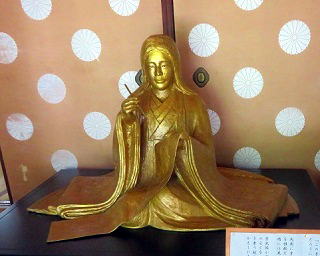
Murasaki Shikibu Statue(Rosan-ji.Kyoto)
The protagonist of the story is
"Hikaru Genji," the son of the Emperor (Crown Prince), but due to his
mother's low social status, he carries the fate of not being able to become
Emperor. Such misfortune based on birth was not uncommon during this time when
people were evaluated more by their status than their abilities. There were
many who swallowed tears at every turn. The novel depicts the romantic
relationships between Hikaru Genji, burdened with such a handicap, and many
women, overcoming misfortune, rising in society, and eventually falling, in a
three-part structure (though some argue for a two-part structure). As you may
know, I'll provide a brief overview of the structure and the skillful
expressions for reference.
■「Structure of the Story」
◎ Part Two (Chapters 34 "Wakaba" - 41 "Kumogakure")
...illustrates the breakdown and downfall of Hikaru Genji's romantic life
at its peak, and the romantic entanglements of his children.
- Parts one and two are centered around
Hikaru Genji.
- Chapters 45 "Hashihime" - 54 " Yumeno-ukihashi" are
known as the "Ten Chapters at Uji."
■「Diverse Characters and the Author's Skillful Expression」
①
"The narrative avoids directness, employing a roundabout touch by
effectively utilizing 795 waka poems to express the essence of romantic
affairs."
②
"Among the 400-plus characters, the strategy of introducing various types
of women who are romantically involved with Hikaru Genji and enhancing the
story with scenes full of both detestable and intimate details can be
observed."
③ "The text is written in hiragana rather than kanji." These aspects
reveal Murasaki Shikibu's deep thoughtfulness and exceptional skill in
writing this novel.
| About the Author,Murasaki Shikibu |
①Birth and Residence
Murasaki Shikibu was born in the late 970s (there are various theories
ranging from 970 to 978) as the second daughter of a middle-ranking aristocrat
at the location of Rozan-ji Temple (currently located in Kamigyo-ku, Kyoto).
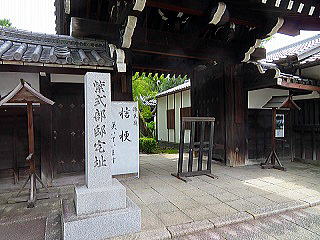
Murasaki Shikibu's Residence site(Rozan-ji Temple)
Her father was the Confucian scholar Fujiwara no Tametoki, and her mother passed away early. The place of her birth was a mansion built about 100 years earlier by her great-grandfather, the middle counselor Fujiwara no Kanesuke, and later inherited by her father, Tametoki. It was a spacious mansion located along the Kamo-gawa River, close to the Imperial Palace, with a garden of white sand and moss (known as "Genji's Garden") where purple bellflowers bloomed from June to early September. Murasaki Shikibu spent much of her time in this mansion.
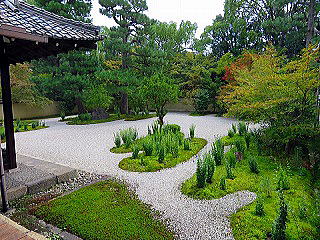
Murasaki Shikibu love "Genji's Garden"
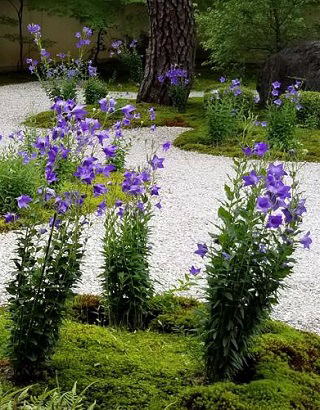
Bellflower
She accompanied her father, who served as the Governor of Echizen, to Fukui
for a while, but returned to Kyoto from Fukui after three years. In her
late twenties, she married Fujiwara no Nobutaka, who was 20 years older
than her, and gave birth to a daughter, Kenko (who later achieved success
and was called "Daini-no-Sanmi").
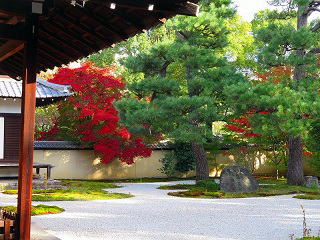
Tranquil Atmosphere of "Genji-Garden"
②Murasaki shikibu as a Writer and Poet and the Background of the Era and
Her Struggles
▽Murasaki Shikibu's Talent
Murasaki Shikibu's literary talent was
evident from a young age. While her father, a Confucian scholar, struggled to
teach her brothers classical Chinese, Murasaki Shikibu quickly grasped
understanding of the language. Later, she broadened her literary knowledge by
reading various works such as anthologies of poetry and historical books.
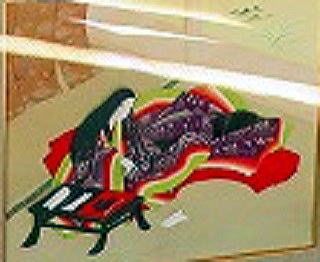
Painting of Murasaki Shikibu
As she grew older, she expanded her
knowledge and experience through interactions with a wide range of people and
witnessing various aspects of life, nature, and regional characteristics
firsthand.
▽Background of the Era
Meanwhile, the aristocratic society at the
time was characterized by a strict class system and stark differences based on
social status. Polygamy was the norm, leading to a mixed bag of emotions and
experiences for women.
▽Struggles to Obtain Japanese Paper and ink
Furthermore, during this era, obtaining
Japanese paper and ink was challenging for lower-ranking aristocrats, despite
being easier for the nobility. Japanese paper and ink were considered valuable
commodities. Therefore, it is believed that writers and poets, including
Murasaki Shikibu, struggled to obtain Japanese paper. It is said that they went
to great lengths, using various means to acquire Japanese paper, sometimes
resorting to tactics to get closer to nobility to obtain it. It is evident that
Murasaki Shikibu had to overcome such obstacles in her writing.
③Motivation for Writing The Tale of Genji
▽Death of Husband
After the sudden death of her husband, Fujiwara no Nobutaka, Murasaki Shikibu,
who was left to raise their daughter Kenko on her own, began writing The
Tale of Genji, perhaps to distract herself from the grief of his passing.
This occurred in the year 1001 (Chōho 3).
▽Supportive Group Recognizing Literary Talent
The
Tale of Genji, which Murasaki Shikibu began writing, often became the topic of
conversation among the women in the palace, attracting the attention of those
who recognized her literary talent. One such person was the powerful nobleman
of the time, the Chancellor Fujiwara no Michinaga. During this period, it was
said that Murasaki Shikibu had difficulty obtaining Japanese paper, and The
Tale of Genji was written when she had access to it. With Fujiwara no Michinaga
as her supporter and sponsor, Japanese paper became more readily available, and
her writing progressed significantly.
▽Service at Imperial Court,Enriching Both Experience and Story
Around 1006 (Kankō 2), five years after she began writing the story, at
the behest of Fujiwara no Michinaga, Murasaki Shikibu began serving as
a lady-in-waiting and tutor to the daughter of Michinaga and the Empress
of Emperor Ichijyo at the time, Shōshi.
While working in a prominent position was not her strong suit, she accumulated
a wealth of knowledge through various experiences at the court. The abundant
availability of Japanese paper also facilitated her writing process, allowing
her to make considerable progress with her pen.
◎Ishiyama-tera Temple(Otsu-City)
Murasaki Shikibu visited Ishiyama-tera Temple (currently located in Ōtsu,
Shiga Prefecture), which was built using rocky terrain.
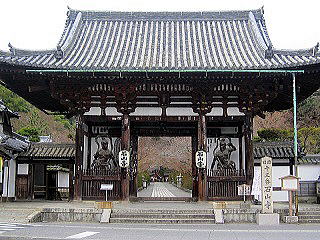
Ishiyama-tera Temple
At the time, it was customary to visit temples when one had wishes or concerns,
and Ishiyama-tera Temple was frequented by many. In August of 1004 (Kankō
1), Murasaki Shikibu visited Ishiyama-tera Temple and stayed in a room
in the main hall for a week. 。
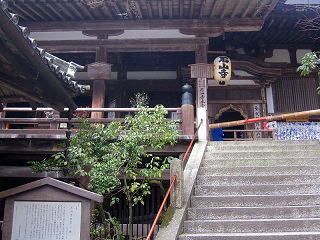
Main holl of Ishiyama-tera Temple
She was deeply moved by the moon reflected on Lake Biwa during the night
of the full moon. The scene of the moon she saw at Ishiyama-tera Temple
is thought to have been reflected in a passage of Chapter 12, "Suma,"
which begins with "On such a night, lit by the full moon...,"
suggesting that she recalled the moon scene she witnessed at Ishiyama-tera
Temple and incorporated it into a passage of The Tale of Genji.
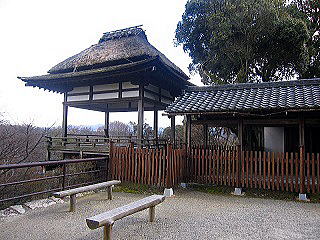
Moon Viewing Stand(Ishiyama-teraTemple)
The room where Murasaki Shikibu stayed is
called the "Genji Room," and many fans of Murasaki Shikibu visit it
to this day.
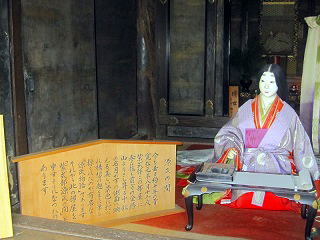
"Genji Room"(Ishiyama-tera Temple)
◎Uji River(Uji City)
Although there is no record of Murasaki Shikibu actually visiting Uji,
the fact that the "Ten Chapters at Uji" from "The Lady of
the Bridge" to "The Floating Bridge of Dreams" are set in
Uji suggests that the mist rising from the Uji River was an essential setting
for the story. .
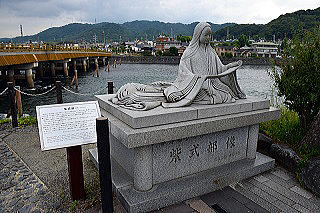
Uji River and Murasaki Shikibu
Therefore, it is speculated that Murasaki Shikibu visited Uji at some point
and gazed at the mist rising from the river.Numerous Murasaki Shikibu monuments
have been erected along the banks of the Uji River in Uji City.
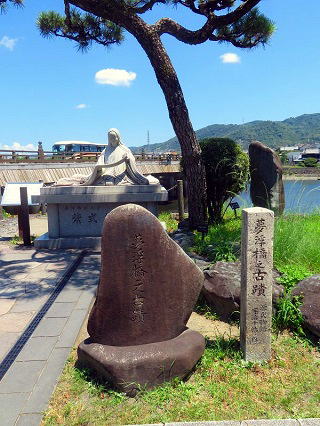
Monument to The Tale of Genji(Yume-no-Ukihashi)
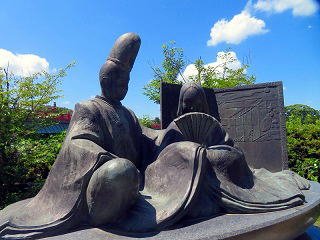
Statue of The Tale of Genji
Many people who trace the footsteps of the female writer Murasaki Shikibu
visit there every year, spanning over 1000 years of history.
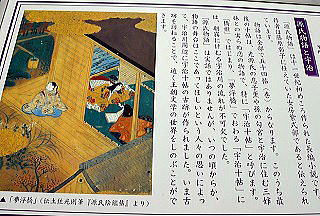
Signboard about "The Tale of Genji and Uji"
④Completion of the Tale of Gebji after Neary 10 Years
It is said that
The Tale of Genji was completed around 1010 (though there are various theories)
after about ten years of writing. From a young age, Murasaki Shikibu studied
classical Chinese and read extensively, gaining various knowledge and
experiences.
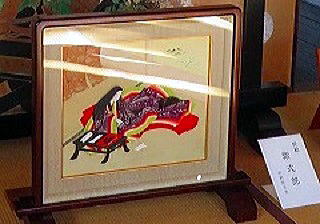
Murasaki Shikibu
Additionally, her marriage experience, the
appearance of influential supporters who highly valued her literary talent, her
various experiences at the court, the social hierarchy of aristocratic society,
and her travels to different regions provided her with a wide range of
knowledge. It was a long novel that she continued to write while appealing to
her own desires and struggles in society at the time.
⑤After Completing the Story...
After completing the epic work, Murasaki Shikibu continued to serve at
the court, first under Empress Shōshi and later under Empress Syoushi,
even after the death of Emperor Ichijō. However, she eventually passed
her duties on to her daughter, Kenko, who served as her replacement when
Empress Syōshi became the Queen Mother.
◎Writing "The Murasaki Shikibu Diary"during Service at the Court
During her service at the court, from 1008 (Kankō 5) to 1010 (Kankō 7),
Murasaki Shikibu completed "The Murasaki Shikibu Diary." The
first half primarily records the birth of Empress Shōshi's child and the
celebrations afterward, while the latter half details Murasaki Shikibu's
personal thoughts about the people she worked with at the court.
⑥Life After Leaving the Court After completing...
The Tale of Genji and The Murasaki Shikibu
Diary, showcasing her literary talent and captivating readers, Murasaki Shikibu
spent her later years at the Unrin-in Byakugo-in (a temple located in Kitaku,
Kyoto), where her grave is currently located. The year of her death ranges from
1014 (Chōwa 3) to 1031 (Chōgen 4), depending on various researchers'
interpretations.
◎The Mistery of the Adjacent Grae to Murasaki Shikibu's Tomb!
Adjacent to
Murasaki Shikibu's tomb, another grave is located.
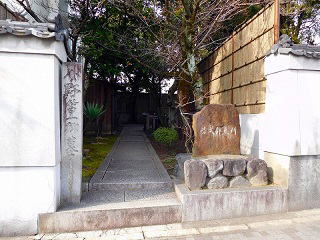
Entrance to the Tomb of the Two
This grave belongs to Ono no Takamura, a bureaucrat
and poet known from the early Heian period who served Emperor Saga. There is
speculation about why the two graves are adjacent since their time periods
differ.
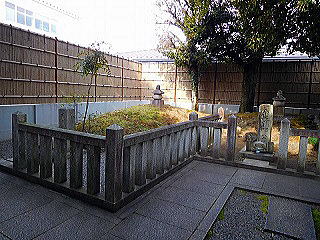
Murasaki Shikibu(left saide)、Takamura(right side)
Legend has it that when it was rumored that
Murasaki Shikibu would fall into hell because The Tale of Genji revealed the
love affairs of the court, and society was outraged, Ono no Takamura moved his
grave next to hers to save her.
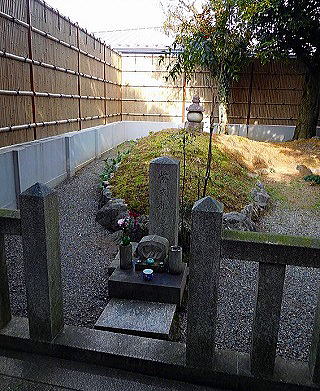
The Tomb of Murasaki Shikibu
Another legend suggests that Ono no Takamura asked King Enma to save Murasaki
Shikibu, and in return, he moved her grave next to his. The truth remains
a mystery, and it is a topic of conversation among those who visit the
site where Murasaki Shikibu rests.
| Murasaki Shikibu and Her daughter,Kenko(Daini no Sanmi) |
Murasaki Shikibu gave birth to her daughter Kenko around 999 (Chōho 1)
and, after her husband's death three years later, raised Kenko single-handedly
while writing The Tale of Genji and working at the court. It is speculated
that Kenko, who grew up watching her mother, inherited her mother's talent
as a poet. Kenko also served in the court like her mother, becoming a wet
nurse to Emperor Go-Reizei in 1025 (Manju 2) and later being promoted to
the rank of “Daini no Sanmi” upon Emperor Go-Reizei's accession to the
throne.
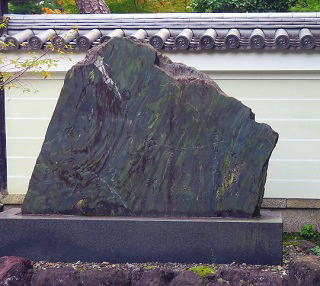
Monument of Murasakishikibu & Kenko
It is believed that Kenko continued to grow under her mother's love and education, leading a fulfilling life. The poems composed by this mother and daughter, known as poets, are consecutively selected inTthe Hyakunin Isshu anthology.
The Hyakunin Isshu anthology... is a classical Japanese anthology of one
hundred Japanese "Waka" by one hundred poets.
▽Murasaki Shikibu (Verse 57)
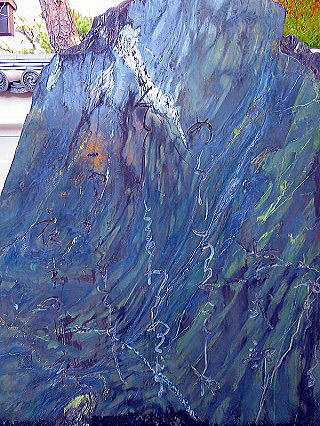
Poem-monument of Murasakishikibu
"I thought I finally met you after a long time, But before I could
recognize it was you, You hurriedly left.
It's like the midnight moon disappearing behind the
clouds!"
The original poem →”めぐり逢いて 見しやそれともわかぬ間に
雲隠れにし 夜半の月かな”
▽Daini no Sanmi(Verse 58)
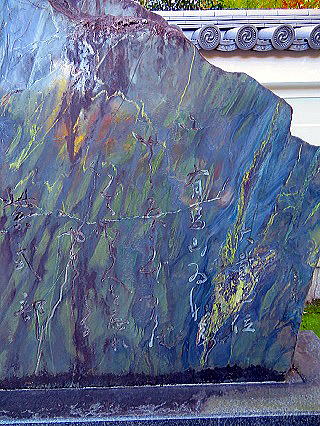
Poem-monument of Daini no Sanmi
"When the wind blows through the bamboo grass fields of Ina near Mount
Arima, it sways with a gentle rustling sound.
However, just like the swaying of those grasses, my heart remains steadfast
and will never forget you!" (Forget you? That could never happen!)
The original poem →
いでそよひとを 忘れやはする”
Copyright © 2009~ Oh! 元気 ねっと All Rights Reserved